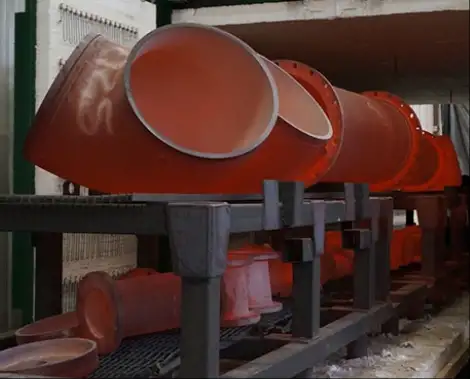While both oxidation and rust affect ductile iron, they represent distinct corrosion processes with different prevention strategies. Oxidation forms a protective patina (iron oxide layer) that slows further degradation, whereas rust (iron oxide hydroxide) is a destructive, flaky corrosion product caused by moisture and electrolytes. For ductile iron pipes, effective protection includes:
-
Polyethylene encasement (AWWA C105) for buried pipes
-
Epoxy/polyurethane coatings for exposed surfaces
-
Cathodic protection in high-risk environments
Learn how material composition and environmental factors determine corrosion rates, and why proper coatings are critical for infrastructure longevity.

🔬 Oxidation vs. Rust: Defining the Terms
Oxidation
Oxidation is a chemical reaction where a metal reacts with oxygen, forming an oxide layer on its surface. In ductile iron, this process leads to the formation of a protective oxide layer that can shield the underlying metal from further corrosion. This oxide layer is typically stable and adheres well to the metal surface, providing a degree of protection.
Rust
Rust is a specific type of corrosion that occurs when iron reacts with water and oxygen, forming iron oxide (Fe₂O₃·nH₂O). Unlike the protective oxide layer formed during oxidation, rust is flaky, porous, and does not adhere well to the metal surface. This characteristic allows moisture and oxygen to penetrate deeper into the metal, accelerating the corrosion process.
🧪 Corrosion Mechanisms in Ductile Iron
Ductile iron, while more resistant to corrosion than traditional cast iron, is not immune to it. The corrosion mechanisms in ductile iron include:
-
Graphitization: The leaching of iron from the microstructure, leaving behind graphite flakes that can weaken the material.
-
Pitting Corrosion: Localized corrosion leading to the formation of pits on the metal surface.
-
Uniform Corrosion: Even corrosion across the surface, often due to environmental factors like soil composition or water chemistry.
Understanding these mechanisms is essential for implementing effective corrosion control strategies.
🛡️ Protective Measures Against Corrosion
1. Coatings and Linings
Applying protective coatings or linings can significantly enhance the corrosion resistance of ductile iron. Common options include:
-
Epoxy Coatings: Provide a barrier against moisture and chemicals.
-
Polyethylene Sleeving: Offers protection in aggressive soil conditions.
-
Cement Mortar Linings: Used in water pipelines to prevent internal corrosion.
2. Cathodic Protection
This technique involves applying a small, continuous electric charge to the metal to counteract the electrochemical reactions that cause corrosion. It is particularly effective for buried pipelines.
3. Regular Maintenance and Inspection
Routine inspections can help detect early signs of corrosion, allowing for timely interventions. Maintenance practices include cleaning, monitoring environmental conditions, and repairing any damage to protective coatings.
📊 Comparative Overview: Oxidation vs. Rust
| Feature | Oxidation (Protective) | Rust (Destructive) |
|---|---|---|
| Formation Conditions | Oxygen exposure | Water + Oxygen |
| Appearance | Stable oxide layer | Flaky, reddish-brown |
| Adhesion to Metal | Strong | Weak |
| Protective Qualities | Yes | No |
| Accelerates Corrosion | No | Yes |
🧭 Best Practices for Ductile Iron Maintenance
To maximize the lifespan of ductile iron components:
-
Select Appropriate Materials: Choose corrosion-resistant alloys or coatings based on environmental conditions.
-
Implement Protective Measures: Use coatings, linings, and cathodic protection as needed.
-
Conduct Regular Inspections: Monitor for signs of corrosion and address issues promptly.
-
Maintain Environmental Control: Manage factors like moisture and chemical exposure that can accelerate corrosion.
❓ Frequently Asked Questions (FAQs)
1. What is the difference between oxidation and rust in ductile iron?
Oxidation refers to the formation of a stable oxide layer on the surface of ductile iron when exposed to oxygen. This layer can protect the underlying metal from further corrosion. Rust, on the other hand, is a form of corrosion that occurs when iron reacts with water and oxygen, leading to the formation of iron oxide that is flaky and does not adhere well to the metal surface, allowing further corrosion to occur.
2. How can I prevent corrosion in ductile iron pipes?
Preventive measures include applying protective coatings such as epoxy or cement mortar linings, using polyethylene sleeving in aggressive soil conditions, and implementing cathodic protection systems. Regular maintenance and inspections are also crucial to detect and address early signs of corrosion.
3. Is ductile iron more resistant to corrosion than cast iron?
Yes, ductile iron has superior corrosion resistance compared to cast iron. This is due to its microstructure, which provides better strength and toughness, reducing the likelihood of corrosion-related failures.
4. Can rust on ductile iron be removed?
Yes, rust can be removed using mechanical methods like wire brushing or abrasive blasting, followed by the application of protective coatings to prevent further corrosion.
5. What are the signs of corrosion in ductile iron components?
Signs include discoloration, pitting, surface scaling, and in severe cases, structural weakening or perforation of the metal. Regular inspections can help identify these signs early.
🧾 Conclusion
Understanding the differences between oxidation and rust is essential for maintaining the integrity of ductile iron components. While oxidation can provide a protective layer, rust signifies ongoing corrosion that can compromise the material’s strength. Implementing appropriate protective measures and regular maintenance can significantly enhance the lifespan and performance of ductile iron products.
